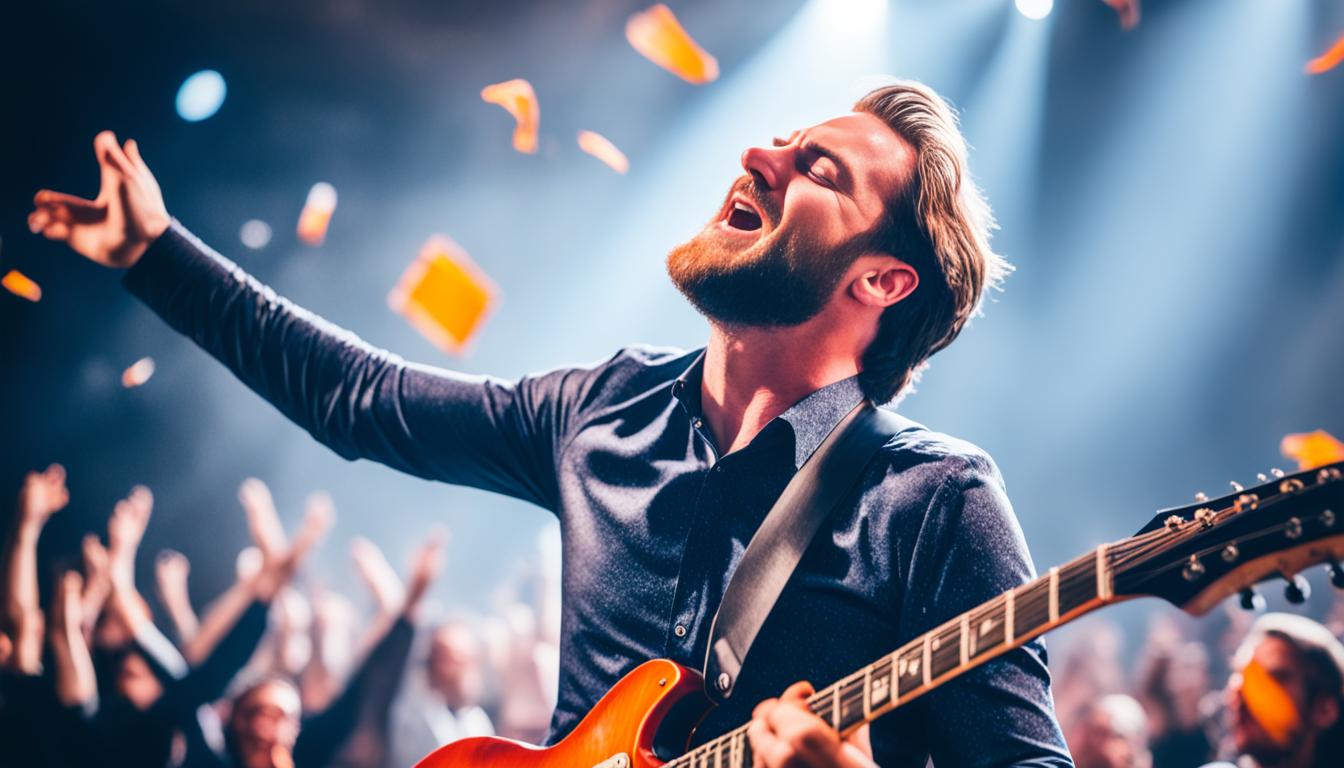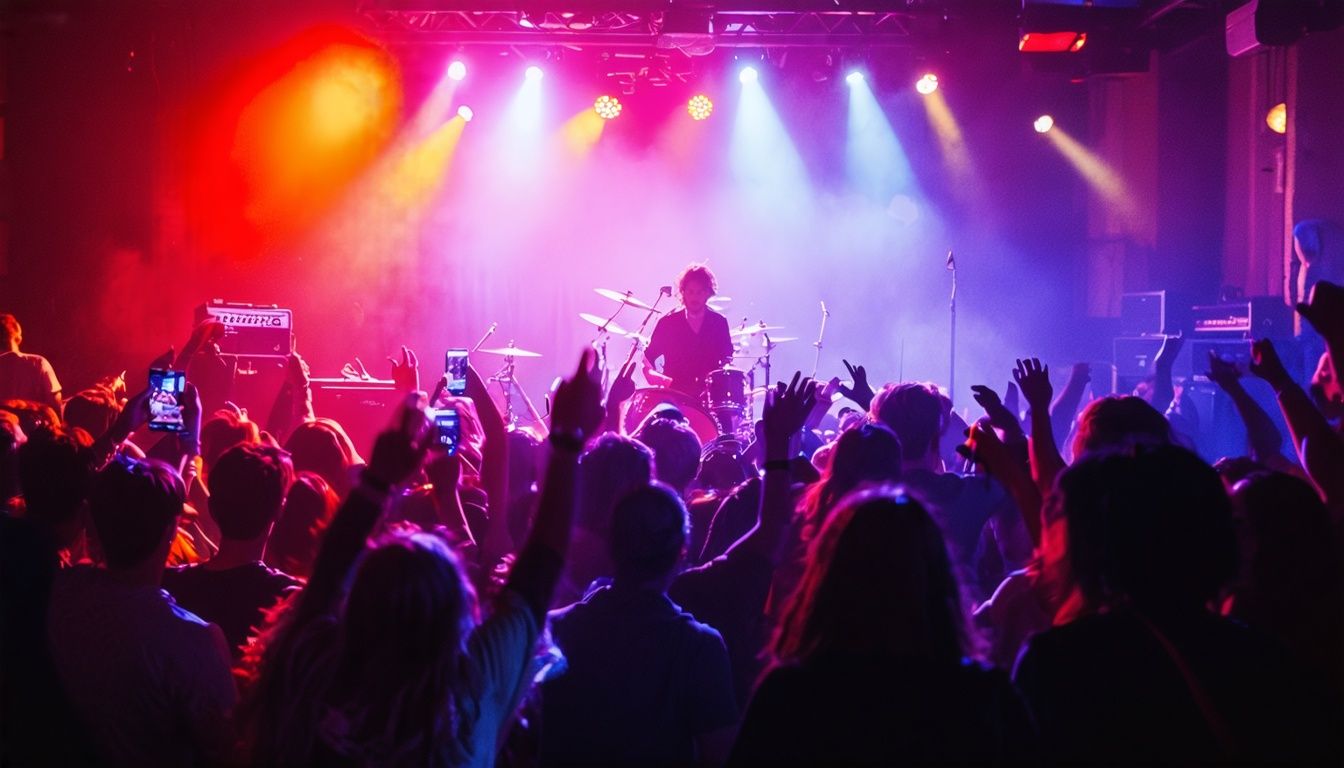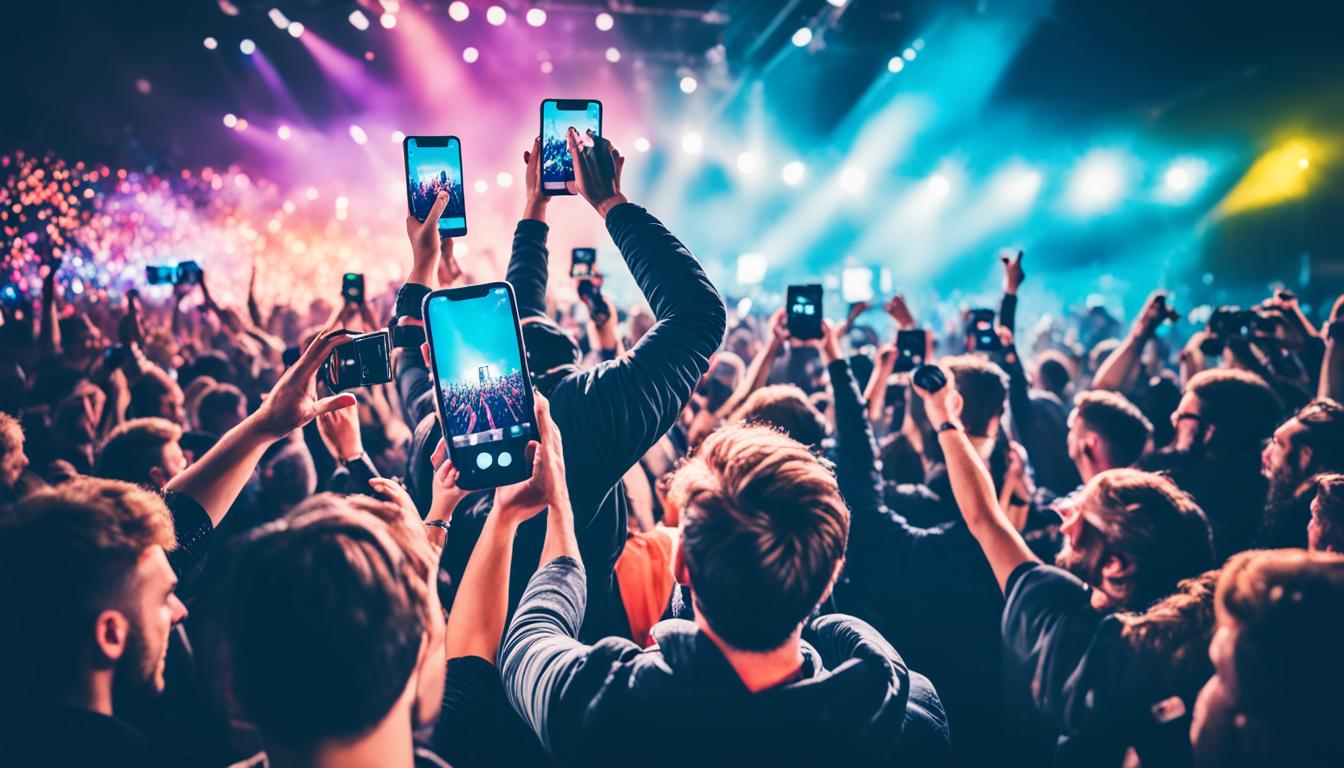We are deeply passionate about music photography. We’ve experienced the electric feeling of live music events firsthand. Each strum and beat pulses with emotion, waiting to be captured. We’ve seen everything from raw moments in cozy venues to the grand scenes at sold-out arenas. This experience has helped us master capturing emotion and expression in concert photography. Chasing that perfect shot—a visual poem that captures a meaningful moment—is thrilling.
Concert photos are more than just pictures; they carry feelings. They bring us back to the intense experience of the music. Over the years, we’ve honed our ability to catch the subtle signs from performers. We predict their next move to seize those fleeting, powerful emotions. These are the emotions that echo long after the concert ends.
Key Takeaways
- Anticipation is key in capturing expressive moments in music photography.
- Immortalize the raw emotion of concerts by focusing on dynamic expressions and artists’ interactions.
- A deep understanding of both technical skill and artist behavior is crucial for live music photography.
- The energy and emotion of the music can be conveyed through well-timed, articulate concert photos.
- Maintain a balance between enjoying the performance and staying alert for photo opportunities.
Introduction to Capturing Emotion and Expression in Concert Photography
When we dive into concert photography, we’re after more than just pictures. It’s about the art of capturing emotions in photos. We find ourselves immersed in the event’s feel, all while staying alert to catch those precious, emotional moments with our cameras.
Concert photography is the harmony of sight and sound, capturing the unspoken tales told by a musician’s fervent glance or an ecstatic leap that resonates with the beat.
We’ve shot everything from lively indie bands to the quiet moments in jazz bands. Every concert lets us record not just an event, but a story filled with feelings. This has shown us how important it is to be visually engaged and listen carefully. It helps us know when the time is right to capture a special moment.
For us, concert photography is more than just technical skills; it’s about connecting with the music through our lenses. When we nail it, the emotion jumps from the stage right into the photo. The energy, the fire, and the tales they tell, all come together in each shot we take.
| Element of Emotion | Technique for Capturing | Impact on Final Image |
|---|---|---|
| Performer’s Passion | Anticipation and Timing | A memorable snapshot of raw fervor |
| Dynamic Energy | Continuous Shooting Mode | Sequential story of performance |
| Subtle Interaction | Zoom Lenses and Composure | Intimate close-ups revealing deeper emotions |
| Audience Engagement | Wide-Angle Perspectives | Wide frame capturing performer-audience connection |
At its core, concert photography lets us be both observers and storytellers. Every photo reflects our bond with the music’s rhythm and the feelings it stirs. Our journey in photography enhances our story of the colorful world of live music.
Understanding the Dynamics of Live Music Photography
The vibrant world of live music photography is more than just capturing artists on stage. It’s about documenting the concert’s soul. Light, shadow, and human emotion are combined to preserve unforgettable moments.
The Role of Lighting in Conveying Mood
Each live performance has its own feel, shaped by lighting. The way light moves across the stage can stir different feelings. Knowing how to handle manual exposure helps capture the mood’s essence.
We focus on adjusting to the colors and light levels, paying attention to white balance settings. This helps in expressing emotion and capturing moments in concert photography.
Anticipating Key Moments for Emotional Impact
A guitarist’s solo or a singer’s heartfelt scream can be powerful. We try to foresee these emotional highs to get meaningful pictures. These moments are the heart of capturing emotion and expression in concert photography.
The Relationship Between Musicians and Photographers
When artists and photographers work in harmony, magic happens. Our chats with musicians can turn into partnerships, leading to inspiring album covers or promotional images. It’s in these collaborations that we find deep emotional connections.
| Aspect | Role in Live Music Photography | Impact on Emotion |
|---|---|---|
| Lighting | Creates atmosphere and drama on stage | Influences mood and viewer’s perception of the scene |
| Anticipation | Preparation to capture defining moments | Emphasizes the emotional peak of performance |
| Artist-Photographer Connection | Builds trust and opens up avenues for creativity | Enhances the authenticity and emotional depth of images |
Concert photography goes beyond simple documentation. As photographers, we use our skills and instincts to find that one striking image. An image that shows the emotion in live music, making each performance memorable.
Essential Gear for Concert Photographers
Concert photography combines the photographer’s skill with essential equipment. To capture the emotion in concert photography, one needs the right tools. These tools must match the photographer’s quick movements and sharp eye. Over time, we’ve found gear that meets the tough conditions of live concerts.
We started with the Nikon D70. Now, the Nikon D810 is our go-to camera. It offers excellent high ISO output and keeps images clear and detailed. Yet, the camera alone isn’t enough. The lenses we use are key for catching every big moment and quiet exchange on stage.
Here’s our favorite lenses for their adaptability and top-notch quality:
- 24-70mm f/2.8: Our main lens, perfect for wide to medium shots. It’s vital for showing the full range of emotion in concert photography.
- 70-200mm f/2.8: This lens helps us zoom in on personal moments. It captures the true energy of music photography.
- Fisheye Lens: Sometimes, a fisheye lens brings a dramatic touch. It offers a fresh perspective that can amplify a performance’s impact.
How we use our camera is crucial in concerts. We prefer manual settings. They let us manage the fast-changing and tricky stage lights. We’ve become experts at using these settings, so we can capture the lively expressions and atmosphere.
Besides gear, knowing the band’s story is important. We blend our photography skills with careful planning. This helps us understand the band’s emotional depth. By doing this, we don’t just take pictures, we tell stories. It’s this combination of technical knowledge and emotional insight that helps us share the real vibe of a concert.

Each high and quiet moment in concert photography is a chance to create something lasting. With the right gear, we’re ready to capture it all. Every shot is a tribute to the vibrant world of live music.
Techniques for Capturing Expression in Low Light
Taking pictures at concerts, we face the challenge of low light photography. This pushes us to improve our photography techniques. It’s especially important when we want to capture the range of emotions at live music events. In this part, we’ll talk about capturing expressions in tough lighting.
Focusing on the Eyes: The Windows to Emotion
The eyes are key to capturing expression. When lights dim and the spotlight shines, we pay attention to the eyes. Using a single autofocus point helps us focus fast and accurately. It makes sure we catch the essence of each moment.

Deciding Between Manual vs. Automatic Settings
Choosing manual or automatic settings is a big debate. But for concert photos in low light, it matters a lot. Manual settings let us adjust to changing lights. Automatic settings help catch quick, intense moments that are easy to miss.
Adjusting Exposure for Dramatic Effect
We aim to tell a story with light and shadow, not just take a photo. Adjusting exposure is key to this. By changing exposure, we create dramatic images. These images capture the concert’s energy and the excitement of the audience.
| Technique | Benefits | Consideration |
|---|---|---|
| Single Point Autofocus | Sharp, precise focus on the eyes | Requires practiced timing and composition |
| Manual Exposure | Control over challenging lighting conditions | Demands a thorough understanding of camera settings |
| Automatic Modes | Quick response to dynamic stage action | Potentially unpredictable in highly variable lighting |
| Exposure Adjustment | Enhances drama and captures emotion | Must maintain balance to avoid over or underexposure |
The Art of Storytelling Through Music Photography
In the symphony of storytelling in photography, we each hold the power to capture emotions in photos. These photos echo beyond time and space. Music photography is more than just snapping shots. It’s about creating a story that moves people, connecting with our hearts to tell profound tales.
As the concert starts and the audience quiets, a rich emotional tapestry unfolds. Looking through our cameras, we tune into the emotion in concert photography. Each shutter click marks a heartfelt moment, capturing life’s highs and lows.
We capture the deep intimacy of quiet concert moments. Like a musician’s thoughtful break or a soft whisper. These moments show the true power of storytelling in photography. They complement the music, highlighting its stories.
“To photograph is to hold one’s breath when all faculties converge in the face of fleeting reality. It is at that moment that capturing an image becomes a great physical and intellectual joy.” – Henri Cartier-Bresson, paraphrased
Music photography offers us a rich scene to capture:
| Crescendo Moments | Silent Interludes |
|---|---|
| A jubilant leap, the arch of a back, the throw of a head back in unadulterated ecstasy | A hushed auditorium, the gentle strumming of strings, a shared glance between artists |
| Explosive riffs, a drumbeat that thrills the audience | Reflective melodies that bring back memories and inspire dreams |
| Colored lights that paint the stage with raw emotion | The song’s last note lingering as it fades away |
Each concert writes a chapter, and every picture tells part of the story. We are more than just photographers. We are poets of unseen verses, aiming to capture emotions in photos. Our cameras tell stories, make memories last, and keep the spirit of music alive forever.
Networking and Growing as a Concert Photographer
The path to becoming a great concert photographer involves more than skill. It’s also about making connections within the photography network. By connecting with others, we share knowledge and support. Thanks to social media and photography platforms, reaching out is easier than ever.
Collaborating With Other Creative Minds
Working in concert photography often means teaming up with others. We blend different viewpoints with other photographers and musicians. This not only improves our work but also lets us capture unique moments in live music photography.
Utilizing Social Media and Publications to Share Your Work
We share our journey and work across social channels. This lets us show our art through powerful images. By using social media and photography, we reach more people and keep up with concert photography trends.
Turning a Memorable Shot Into an Opportunity
Our photos do more than capture a moment—they open doors. A great shot speaks to people, showing the deep feeling of capturing expression during an exciting performance.
| Tips for Effective Networking | Benefits of Social Media Sharing | Transformative Impact of a Great Concert Photo |
|---|---|---|
| Build genuine relationships with other creatives | Increased visibility and engagement | Open doors to exclusive photography assignments |
| Offer to collaborate on projects | Feedback from the photography community | Establish your brand and reputation in the industry |
| Share knowledge and resources generously | Connect with potential clients and collaborators | Memorable shots can lead to gallery showings or publications |
Conclusion
The world of concert photography is magical. It’s where light and shadow meet to tell stories. Each photo we take captures the deep feelings music brings to life. This art tells stories of energy, motion, and emotion, connecting beyond just sounds.
Taking great concert photos means more than just having a good camera. It’s about feeling the music and the crowd’s energy. This connection creates pictures that tell stories. Stories of joy, passion, and moments that music fans and musicians share.
We hope our stories inspire other photographers. The journey has its ups and downs but brings great joy. For us, photography captures more than moments. It’s about showing the deep impact of music through our photos. Concert photography is not just a job, it’s a way to share the magic of music.
FAQ
What makes emotion in concert photography so vital?
Emotion is the heart of concert photography. It turns a simple photo into a strong memory. It shows the passion and energy of live music. Capturing a performance’s intensity helps us connect with the event.
What techniques can be used to capture emotions in concert photos?
Techniques include waiting for key moments, such as a song’s climax. Focus on expressive details like eyes and hands. Use fast shutter speeds to freeze motion. Adjust exposures for effect and master low light photography.
How important is it to understand the dynamics of the band for live music photography?
Knowing the band’s dynamics is key in live music photography. It lets us foresee interactions and emotions between members. Understanding their music and style helps spot special moments that highlight the concert.
What gear do concert photographers typically use?
Concert photographers use cameras good in low light and with high ISO settings. They prefer versatile lenses like the 24-70mm and 70-200mm f/2.8. A fast lens is crucial for sharp photos in dim light.
How do you capture expression in low light environments?
To capture expression in low light, mix technical skills with the right equipment. Adjust exposures, use fast lenses, and focus on the artist’s eyes. Post-processing can also improve the mood of your low-light photos.
What role does storytelling play in music photography?
Storytelling is core to music photography. It creates a narrative through images to show the essence of a performance. Each photo shares a bit of the artist’s journey, adding to the event’s memory.
Can networking help to grow a concert photographer’s career?
Yes, networking is crucial for growing in concert photography. Making connections, sharing work online, and getting published opens new opportunities. Each new contact can lead to another advance.
How does concert photography differ from other types of photography?
Concert photography stands out for its lively and unpredictable nature. Photographers face the challenge of capturing live performance emotions in changing and often tough light. It demands quick reflexes, deep music understanding, and the ability to foresee moments.



